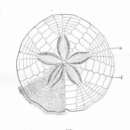en
names in breadcrumbs


For animals relatively high on the evolutionary scale, it is remarkable that a head has never been developed. While five-pointed symmetry or pentamerism is largely displayed by the adult sand dollar, larvae are bilaterally symmetrical (Banister and Campbell 1985). This particular sand dollar displays a somewhat bilateral tendency since it is an "irregular" sea urchin. This simply means that it is flattened and somewhat oval, tending toward a posterior and anterior end.
This species had relatively few predators and is quite hardy. Human intervention does not seem to have a great impact on the numbers of this sand dollar. However, there have been times when oil spills have threatened large populations.
US Federal List: no special status
CITES: no special status
There is no known adverse affect to humans.
This sand dollar burrows in the sand at the sea bottom feeding on algae and fragments of organic material found in the substrate. They scrape off substrate with large, triangular teeth that ring their mouth. The teeth in the center of the mouth are continually growing while being worn away at their free ends. Therefore, although they are held firmly in place by ligaments and other ossicles of the jaws, the teeth must be periodicaly shifted toward the mouth. This shifting is apparently accomplished by tiny muscles (Telford & Ellers 1997).
While burrowing they use their cilia-covered spines to move substrate to their mouth. Their tube feet aid in this process as well. Sand dollars generally feed on the detritus found in the substrate, but they will also feed on small plankton and algae (Grzimek 1972).
Animal Foods: zooplankton
Plant Foods: algae; phytoplankton
Other Foods: detritus
Foraging Behavior: filter-feeding
Primary Diet: detritivore
This species is the common dollar of the North American east coast from New Jersey north. It is circumpolar and also occurs in Alaska, British Columbia, Siberia and Japan.
Biogeographic Regions: arctic ocean (Native ); atlantic ocean (Native ); pacific ocean (Native )
Other Geographic Terms: holarctic
Sand dollars are found in the intertidal zones and a little deeper. Often their skeletons will wash ashore after a storm. They burrow into the sand for protection and for food (Banister and Campbell 1985).
Aquatic Biomes: coastal
This animal lacks the the five arms that are characteristic of the phylum but does posess the same five-part radial symmetry (Raven and Johnson 1999). It is generally about 5-10 cm in diameter when fully grown.
The shell has many small perforations that form a symmetrical petal-like design. The entire shell (or "test," since it is not truely a shell as it is covered by skin) is penetrated by many small, brown spines that give the shell a velvety appearance and enable the animal to move about. Since these creatures have found very effective hiding places in the sand, the spines no longer are needed for protection and have been modified ("Sand Dollar" 1997). The spines on the somewhat flattened underside of the animal allow it to burrow or to slowly creep through the sand. Fine, hair-like cilia cover the tiny spines. These cilia, in combination with a mucous coating, move food to the mouth opening which is in the center of the star shaped grooves on the underside of the animal (Page 2000). The opening for the anus is on the posterior edge of the test.
The holes in the test also allow for the tube feet of the characteristic water vascular system to protrude. These tube feet also aid in moving food to the mouth, as well as in burrowing. The test is divided into sections, each characterized by a calcerous plate that is fused to the next. The plates are either ambulacral or non-ambulacral, either with holes for the tube feet or without. This corresponds to the ambulacral grooves found in the sea stars (Anonymous 1998).
In addition to the small spines on the surface, there are small organs called pedicellariae. These organs are small jawlike structures that were once thought to be parasites.However, upon further observation, it was understood that these organs function in grooming the sand dollar and keeping would-be parasites away. This species posesses the smallest of these organs which functions mainly in grooming (Banister and Campbell 1985).
The calcareous test is what is commonly found washed up on the shore, sans the velvety spines and bleached by the sun.
Range mass: 10 to 25 g.
Other Physical Features: ectothermic ; heterothermic ; radial symmetry
Sexual Dimorphism: sexes alike
The sexes are separate, though there is little distinction between male and female. The possession of either gonad is all that separates the two. Gametes are released into the water column as in most echinoids, and most generally when the water is warm. The free-swimming larvae join the populations of plankton and metamorphose through several stages before the test begins to form and they become bottom dwellers (Page 2000).
Key Reproductive Features: iteroparous ; seasonal breeding ; gonochoric/gonochoristic/dioecious (sexes separate); sexual ; fertilization (External ); broadcast (group) spawning